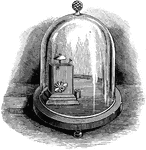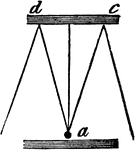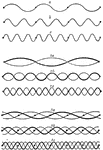Sound
The Sound ClipArt gallery offers 43 images of sound and apparatus used to test the frequency and level of sound. See also the Telephone and Telegraph Industry gallery for many early sound transmitting devices.

Acoustic Earpiece
This is an acoustic earpiece or early design loudspeaker, the speaker moves in accordance with the variations…
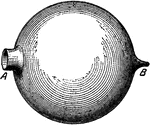
Hemholtz Resonator
"Hemholtz constructed a series of resonators, each one of which responds powerfully to a single tone…
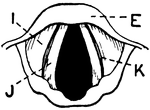
Vertical Section of Larynx
This illustration shows a vertical section of the larynx and its many parts (A. Thyroid Cartilage; B.…
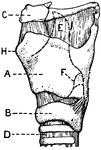
Lateral Aspect of Larynx
This illustration shows a lateral aspect of the larynx and its multiple parts (A. Thyroid Cartilage;…
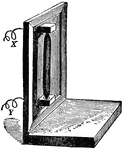
Microphone
An instrument invented byProf. Hughes in 1878, and which is used to increase the intensity of low sounds.
Organ Pipe
"Procure an open organ-pipe, at least one side of which is made of glass. While the pipe is emitting…
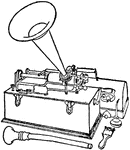
Phonograph
An instrument for recording and reproducing the vibrations of sound. It was invented by Thomas A Edison…
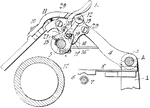
Machine for Phonograph
Any sound-reproducing machine using records in the form of cylinders or discs.

Reflection of Sound Using a Reflector
"Hold a lamp reflector or other large concave mirror directly facing the sun, so as to bring the rays…
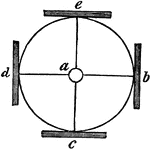
Sound Reflection in a Circle
"In a circle, sound is reflected from every plane surface placed around it, and hence, if the sound…

Sound Refraction
"Fill with carbon dioxide a large rubber toy balloon or other double-convex lens having easily flexible…

Demonstration of Resonance Using a Tuning Fork and Water Column
"Hold a vibrating tuning fork over the mouth of a cylindrical jar about 10 or 18 inches deep, and notive…

Savart Bell and Resonator
"...represents a Savart bell and resonator. The length of the resonant air-column is changed by means…

Siren
"Rotate the disk slowly, blowing meanwhile through a tube of about 3/16 inch bore, the nozzle of the…

Noise Making Siren
A siren is a loud noise maker. The original version would yield sounds under water, suggesting a link…

Sonometer
A sonometer is an apparatus by which the transverse vibrations of strings can be studied. It is also…
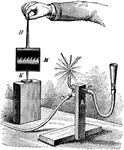
Flame Sonometer
"Apparatus used that will show changes in the flame upon the glass sheet M, when sound is introduced…
Sound Wave, fundamental frequency
"Bow or pluck the string of a sonometer near its end, thus setting it in vibration as a hole. The string…
Sound Wave
"Lightly touch the wire at its middle point with the tip of the finger or the beard of a quill; the…

Tin Can Telephone
A tin can telephone is a type of voice-transmitting device made up of two tin cans, paper cups or similar…

Tone
An example of how to produce a tone. This illustration shows one end of a string fixed to a hook and…
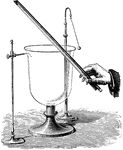
Tone
"A glass bell is fixed to stand, and beside it is a stand carrying a small ivory ball. This is so arranged…

Tone
"If a light strip of steel is firmly gripped at one end in a vice and the other end plucked aside, it…

Speaking Trumpet
"A trumpet-shaped instrument by which the sound of the human voice is reinforced so that it may be heard…
Tuning Fork
A tuning fork is an acoustic resonator in the form of a two-pronged fork with the tines formed from…

Tuning Fork
A tuning fork is an acoustic resonator in the form of a two-pronged fork with the tines formed from…
Tuning-fork
A steel instrument consisting of two prongs and a handle, which, being struck, gives a certain fixed…
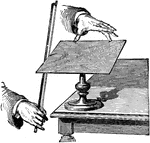
Vibration of Plates
An illustration showing the vibration of plates be using a rosined bow and a steel plate.
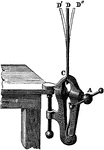
Sound due to Vibrations
"Grasp one end of a straight spring made of hickory or steel in one end of a vise, as shown. Pluck the…
!["The graphic method of studying sounds, which fairly meets even the exacting demands of physicists, and is largely used by them may be briefly explained thus: Suppose the smoked plate [shown] to be a sheet of smoked paper fastened around a cylinder that is mounted that, when it is turned by a crank, the screw cut upon the axis moves the cylinder endwise as shown. Such and instrument is called a vibroscope." -Avery 1895](https://etc.usf.edu/clipart/35900/35992/vibroscope_35992_mth.gif)
Graphic Method of Studying Sounds Using a Vibroscope
"The graphic method of studying sounds, which fairly meets even the exacting demands of physicists,…
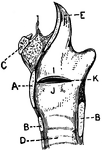
Vocal Cords Seen from above During Phonation
This illustration shows the vocal cords as seen from above during phonation (A. Thyroid Cartilage; B.…

Vocal Cords Seen from above During Quiet Breathing
This illustration shows the vocal cords, seen from above during quiet breathing (A. Thyroid Cartilage;…
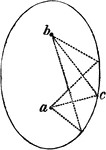
Whispering Gallery
"It is apparent that the auditor, in this case, must be placed in the centre from which the sound proceeds,…
